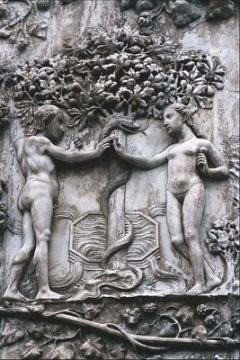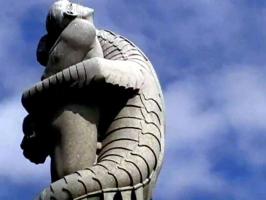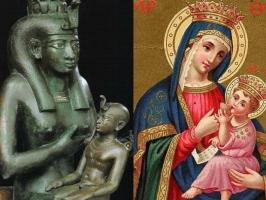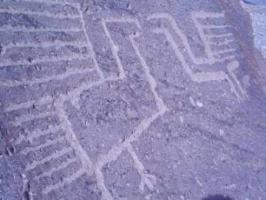Symbolism of serpent in the Canaanites cult and in the Genesis of Hebrews


The most important historical source to know the history of the Jews is the Bible. According to current knowledge, the Bible is a set of texts, compiled from the 13th century BC. The history of the Jews traditionally dates back to Abraham, who lived in Ur, in Mesopotamia, around the 19th century BC.
According to the Bible, Abraham received from God the order to go to Palestine.
Abraham's successors were Isaac and Jacob, considered the father of the Hebrew people since, in effect, his twelve sons led the famous twelve tribes of Israel.
Around the 18th century BC, the Hebrews emigrated to Egypt after a severe famine. After several centuries of prosperous life, the Hebrew ethnic group was persecuted and, under the command of Moses (13th century BC), they settled again in Palestine. After a period of approximately 200 years, during which it was led by a group of Judges, the classical period of its History began, with the kingdoms of Saul, David and Solomon.
At the base of the biblical tradition is the covenant between God, whose Hebrew name was transliterated in YHWH (from the verb "to be"), and man, which, according to tradition, took place on Mount Sinai, when they were given to Moses the tables of the Law, which were later preserved in the Ark of the Covenant.
It is recognized by the majority of historians and epigraphers that the Bible began to be written around the 10th century BC, with the exception of Genesis, which could have been written a century earlier (13th century BC).
It is interesting to analyze why in the Genesis the symbol of the snake was used as an enemy of God, that is, as a tempting entity, associated by many with "Satan", or, "an angel who rebelled against the Creator and wants to reach Knowledge."
Why was "Satan" symbolized precisely by the serpent in Genesis and not by another animal?
It seems that the so-called Yahwist writers, that is, worshipers of YHWH, understood as "Absolute creator of Heaven and Earth", proceeded to choose the snake as a symbol of evil, that is, as a symbol of the "antagonist of God."
The two sacred animals of the Syrian-Canaanite culture were the bull and the serpent.
The snake, in particular, was held in a positive light: as a symbol of life (its skin regenerates indefinitely). It lives in the cracks and for this reason it evokes the concept of the womb, or the generation of life.
The snake has been associated with the Moon since ancient times, since it too is reborn by getting rid of its shadow (from the crescent moon to the full moon). In short, the snake was seen as a symbol of wisdom, since it lives in the underworld and foresees the future.
It should be noted that the snake was a symbol of wisdom and life also in many other pre-biblical cultures, such as in the cultures of India, from which the concept of a snake coiled around itself three and a half times originated, and in American cultures, where the snake is part of the Andean Trinity and is considered a positive entity.
Returning to the cults of the Canaanites, it must be emphasized that their main God, before the arrival of the Hebrews to Palestine, was Baal, God of fertility, of life, who was associated with the serpent and sometimes represented as a divinity. phallic.
In Canaanite mythology, Baal was the son of El, the Creator of the world.
After the arrival of the Hebrews to Palestine, the two gods coexisted: on the one hand, Baal, worshiped for centuries, whose cult was rooted in the substratum of the Canaanites, and, on the other hand, YHWH, who had been introduced by the Hebrews.
From the Book of Judges it is deduced that Gideon (11th century BC) had destroyed an altar dedicated to Baal, meaning that there was a certain rivalry between two factions.
The Hebrew population, on the other hand, had assimilated the two Gods and had carried out a syncretism between them.
Both were seen as generators of life, dispensers of rain and, therefore, promoters of fertility. However, the cult of Baal was so rooted in the population that many worshiped him until the 7th century BC. He was often represented as a bull, but more frequently as a serpent, that is, lunar and eternal.
The conflict between the worship of Baal and YHWH continued, as deduced from Chronicles, when Hezekiah opposed Baalism.
And here we return to Genesis, which has its origins in ancient Canaanite myths. Indeed, we find the tree of life with the serpent at its side (generator of life). However, in Genesis, the role of the serpent is opposite to that of the Canaanite myths.
What did the biblical author want to emphasize?
According to some scholars, the serpent was chosen on purpose precisely to emphasize that what produced life and fertility in Canaan was a source of instability and dissidence in Israel, which distanced man from the true and only God, YHWH, or from the pure monotheistic concept.
After being tempted by the serpent, which is described as a simple “animal” in Genesis, man is expelled from the Garden and no longer has access to the symbols of the tree of life and knowledge. Thus the concept of “guilt” is introduced and God (YHWH) is seen as transcendent, outside of nature, that is, “first cause”, “Absolute”.
It was about the confrontation between different versions of the world: on the one hand, the pantheistic world, where Baal represented one of the Gods and promoted fertility; on the other hand, the new concept of monotheism, or of the “first cause”.
Behold, in Genesis, the serpent is Baal, seen as "evil", or, he offers man knowledge and fertility, but he is punished by God and transformed into a simple animal, converted into a symbol of evil and no longer about life and fertility.
YURI LEVERATTO























